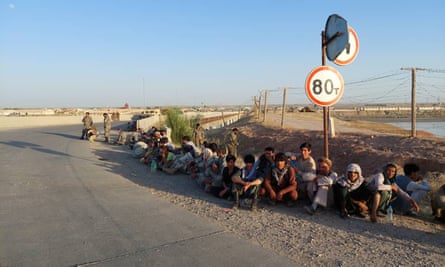The Taliban’s rapid advance through northern Afghanistan continued on Sunday with more than a dozen districts falling to the militants, as Britain entered the final days of its two-decade deployment to Afghanistan.
More than 300 members of the Afghan security forces fled across the border into Tajikistan to escape the militants, and Badakhshan and Takhar provinces are now largely under Taliban control, beyond the respective regional capitals.
There have been no public announcements about when the last British troops will fly out. Senior sources had recently said the US and British missions would end on 4 July, but after Joe Biden backed away from that date at a weekend press conference, London appeared to follow suit.
On Friday the US handed over Bagram airbase, the heart of its campaign in Afghanistan, meaning it can no longer carry out significant operations in the country. The few hundred soldiers left are in effect on guard duty for the embassy.
But at a press conference soon afterwards, Biden brushed off questions about the end of the US deployment, saying it was a holiday weekend and “I want to talk about happy things, man”. Since then his press secretary, Jen Psaki, has reset expectations, saying the last troops would probably be out by the end of August.
On Sunday Britain’s Ministry of Defence said a few British troops remained in Afghanistan, blaming a fast-changing situation and “mixed messaging” for earlier reports of a 4 July departure.
Britain’s plans are expected to become clearer when Boris Johnson makes a statement to parliament early this week, most likely on Tuesday, after a meeting of the national security council (NSC) that will determine the shape of the UK’s future diplomatic and any residual military presence in Afghanistan. But one defence source cautioned that the NSC meeting had been postponed before and it could happen again.
Most of Britain’s 750-strong contribution to what is officially a “train and assist” stabilisation mission in Afghanistan has already left. The NSC meeting is expected to discuss whether any SAS or other special forces will remain in the country – although that decision will not be made public – and whether some troops might be required to guard the British embassy in Kabul, currently protected by contractors. Defence sources said the current arrangement was likely to be continued.
In common with other Nato countries that have ended their missions in recent weeks, the UK appears to be planning a very low-key military departure. Few politicians want to highlight that a military project launched to destroy the Taliban is ending with the group resurgent across the country.
In Kabul, Biden’s holiday weekend remarks prompted outrage, as observers tracked the rapid spread of Taliban control, including in areas such as Badakhshan that 20 years ago had been strongholds of resistance against the militant group.
“As an Afghan woman, I don’t have that option ‘to talk about happy things’. I have to worry about a looming gender apartheid,” Shaharzad Akbar, the head of the Afghanistan International Human Rights Commission, said on Twitter.

The Taliban now control about a third of Afghanistan’s nearly 400 districts and threaten many more. Although they have not yet taken any provincial capitals, they now surround several of them, from Ghazni City in the east to Maimana in northern Faryab province.
In many areas, security forces have surrendered without a fight, sometimes under deals brokered by local elders. Videos showing Taliban embracing surrendering soldiers and providing them with money to travel home may have given government forces confidence that they could abandon their posts without losing their lives.
In Badakhshan, Mohib-ul Rahman, a provincial council member, blamed Taliban successes on the poor morale of troops who are mostly outnumbered and have been left without vital supplies or the possibility of reinforcement.
“Unfortunately, the majority of the districts were left to Taliban without any fight,” Rahman told the Associated Press.
The rapid advance left Badakhshan’s capital at risk, and on Saturday television images showed politicians and government officials crowding on to planes for an evacuation to Kabul.
On Sunday special forces arrived by helicopter to secure the city and potentially try to reclaim some districts. But Afghan security forces have managed to push the Taliban out of only a handful of the places they have seized over the last few months.
